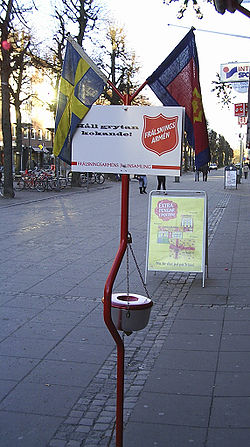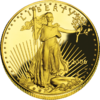- Christmas kettle
-
Part of a series on The Salvation Army 
Background Christianity · Protestantism
Pietism · Anglicanism
Arminianism · Methodism
Holiness Movement
EvangelicalismOrganization General
Chief of the Staff
High Council
Commissioners
Officer · Soldier · CorpsProminent Salvationists William Booth
Catherine Booth
Bramwell Booth
Florence Booth
Evangeline Booth
Ballington Booth
Catherine Bramwell-Booth
Elijah Cadman
Frederick Booth-Tucker
Arthur Booth-Clibborn
George Scott Railton
T. Henry Howard
Theodore Kitching
Ray Steadman-Allen
Eva BurrowsOther topics Brass Bands
Promoted to Glory
Order of the Founder
Limelight Department
Christmas kettle
The War Cry
Articles of War
Reliance BankRelated organisations Volunteers of America
Skeleton Army
The Blind Beggar
Christianity portalChristmas kettle is The Salvation Army's most famous street campaign. It is most recognized during the Christmas season through its volunteers who stand outside of businesses and play or sing Christmas carols, or ring bells to inspire passersby to place donations of cash and checks inside the trademark red kettles.
History
A tradition on the "kettle" started in 1891, in San Francisco, by Captain Joseph McFee.[1] Salvation Army officer Captain Joseph McFee, resolving to provide a free Christmas dinner to the poor of San Francisco, remembered a sight he saw in Liverpool, England. From his days as a sailor McFee remembered a large pot displayed on the Stage Landing, called "Simpson's Pot." The pot took in donations put in by passersby. Taking this idea, McFee asked for permission from San Francisco city authorities to place a crab pot and tripod at the Oakland ferry landing. The kettle - and McFee's call of "Keep the Pot Boiling!" - drew in passengers and donations.
The idea spread, and is in use by many Salvation Army charities worldwide. Innovations from the crab pot have included self ringing kettles, booths that play Christmas music, and Credit Card capabilities.[1]
Anonymous gold coin donations
A tradition has developed in the United States where, in some places, gold coins are anonymously inserted into the kettles in which the bell ringers collect donations. The tradition appears to have started in the Midwest when the first known drop of a gold coin was put into a kettle in Crystal Lake, Illinois in 1982.[2] Since this drop, many others have taken to dropping not only gold coins,[3] but also other bullion and rare coins, gold medals,[4] and jewelry.
Some of the finds include:
- Various bullion coins.
- Rare coins
- United States Quarter Eagle[2]
- United States Double Eagle[7]
- Counterfeit 1804 silver dollar[2]
- Jewelry
- ⅓-carat diamond ring[2]
- Five gold rings (invoking the song The Twelve Days of Christmas)
- Check for $14,845.00[2]
- Gold teeth[8]
In addition, Salvation Army kettles have also collected worthless items like candy, lint and other assorted trash.[6]
Notes and references
- ^ a b The Salvation Army Spokane (Copyright date 2007). "Red Kettles". Archived from the original on 2007-12-12. http://web.archive.org/web/20071212211442/http://www.salvationarmyspokane.org/event_kettles.php. Retrieved 2007-12-20.
- ^ a b c d e f g Oren Dorell (December 7, 2006). "Gold coins from secret Santas bring cheer to Christmas bell ringers". USA Today. http://www.usatoday.com/news/nation/2006-12-07-goldcoins_x.htm. Retrieved 2007-12-20.
- ^ Journal staff (December 19, 2007). "Salvation Army gets 10 gold coins". Rapid City Journal. http://www.rapidcityjournal.com/articles/2007/12/19/news/top/doc47685bec7df96762290528.txt. Retrieved 2007-12-20.
- ^ Journal staff (December 16, 2005). "Gold coin donated again". Rapid City Journal. http://www.rapidcityjournal.com/articles/2005/12/16/news/local/news08.txt. Retrieved 2007-12-20.
- ^ Andrea J. Cook (December 21, 2006). "Red kettle gold converted to green". Rapid City Journal. http://www.rapidcityjournal.com/articles/2006/12/21/news/top/news00l.txt. Retrieved 2007-12-20.
- ^ a b Bill Sheets (November 28, 2007). "Mysterious gold coin dropped in Salvation Army kettle". The Daily Herald. http://www.heraldnet.com/article/20071214/NEWS01/712140076. Retrieved 2007-12-20.
- ^ Mary Stegmeir (December 20, 2007). "Salvation Army kettle yields double eagle gold coin". WCF Courier. http://www.wcfcourier.com/articles/2007/12/20/news/breaking_news/doc476a846856335960905030.txt. Retrieved 2007-12-23.
- ^ Associated Press (December 18, 2005). "Gold teeth donated to Salvation Army kettle". USA Today. http://www.usatoday.com/news/offbeat/2005-12-18-gold-teeth_x.htm. Retrieved 2007-12-20.
Categories:- Charities
- The Salvation Army
- Christmas traditions
Wikimedia Foundation. 2010.


